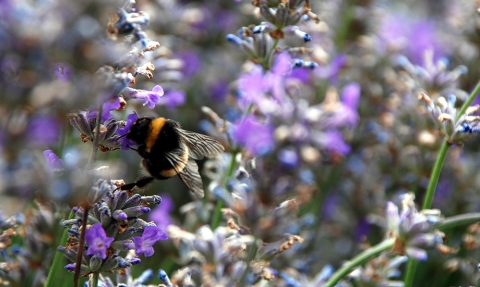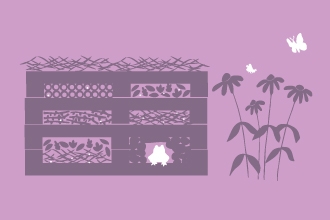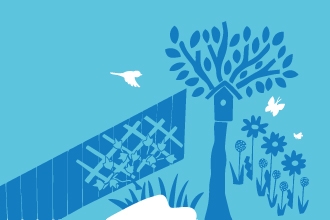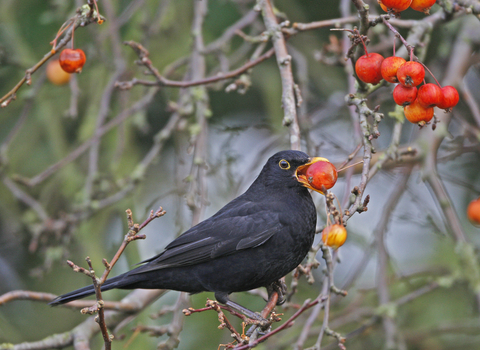
Wildlife Gardening
Use the blank canvas of your new build garden to make your new home a home for wildlife too!
All the noise and disturbance involved in the construction of a house is likely to have frightened away any wildlife. It may be strangely quiet, no birdsong or insects buzzing, but with a bit of encouragement your garden can become a popular destination for a wide range of visitors.
While new build gardens are typically bland, void of plants and you may have to wait a while for anything to establish, the advantage is that you have a blank canvas to work with. Improving the stony, thin, compacted soil requires some effort, but wildflowers actually prefer poor soil, so the conditions are likely ideal for this kind of wildlife-friendly planting.
In your garden
Planning
- Try not to think of your garden in isolation, but as part of a collective of green spaces all linked together – most wildlife needs a ‘corridor’ of sympathetic environments in which to move around. So encourage your neighbours to do what they can to make their gardens as inviting as possible too.
- How you decide to plan your garden can make a huge difference to wildlife communities. Start perhaps with a couple of silver birches, and/or a selection of native shrubs, like holly or guelder rose. This provides shelter for wildlife and benefits your garden generally.
- The garden is a three-dimensional space, not just a piece of ground – try to make use of all the available surfaces, like walls, fences and roofs. The most wildlife-friendly gardens are mostly plants with little ground showing at all! Strangely, the more plants you have, the bigger your garden seems. Even your patio can be enhanced with containers full of nectar-rich plants.
- It may well come with a lawn, which if mown frequently will support relatively little wildlife. Consider dispensing with it altogether in favour of more planting, and perhaps a pond. If you want to keep a grassed area, make a small wildflower meadow that will play host to a multitude of butterflies, bees and other insects.
- However small, there is always room for a pond, something high on the list of favourite wildlife habitats. Even a small sink or tub pond, with a few aquatic plants benefits a large section of the wildlife community.
Establishing
- The tender new shoots of your newly establishing plants might delight the local community of slugs and snails, but don’t be tempted to use pellets containing potentially harmful chemicals; there are plenty of alternative ways of controlling them. Try to accept that they are an inevitable presence but they do provide a delicious meal for frogs, toads, hedgehogs and birds.
- Fix wires and trellis on any appropriate vertical surface to support wildlife-friendly climbing plants such as honeysuckle, jasmine and wisteria. Ivy and Virginia creeper can gallop up a wall or fence unaided and provide an excellent habitat and food source for many creatures.
- Choose plants that are native to your area – a walk around the local countryside will provide inspiration. Or check out the postcode plants database (link below) for a list of all your local plant species.
- Include some feeding stations and nesting boxes to attract animals while your plants are establishing. Don’t forget to put out a shallow bowl of water as a birdbath and drinking source.
Maintaining
- Don’t use fertiliser, wild flowers do best in poor soil
- To get the most out of your wildflower lawn, mow it short in late winter, lifting the clippings, and then leave the next mow until after the flowers have all seeded, in late summer.
- A lawn that hasn’t been fed will benefit from an annual maintenance programme of scarifying and aerating. See link to RHS advice below.
- Any newly grassed area needs regular mowing in its first year to give it a chance to establish.
Top tips
- Don’t dismiss all weeds – a handful of nettles grown in a pot to stop them spreading and tucked away in a sunny corner provides important food for butterflies.
- If you decide to build a patio, leave some gaps in the pavers for extra planting opportunities.
Suggested plants:
- Cotoneaster
- Pyracantha (Firethorn)
- Chaenomeles japonica (Japonica, Japanese quince)
- Hebe
- Skimmia japonica

How to build a bird box
With natural nesting sites in decline, adding a nestbox to your garden can make all the difference to your local birds.

How to build a bug mansion
Build your own bug mansion and attract a multitude of creepy crawlies to your garden.

How to start a wildlife garden from scratch
Use the blank canvas of your garden to make a home for wildlife.

